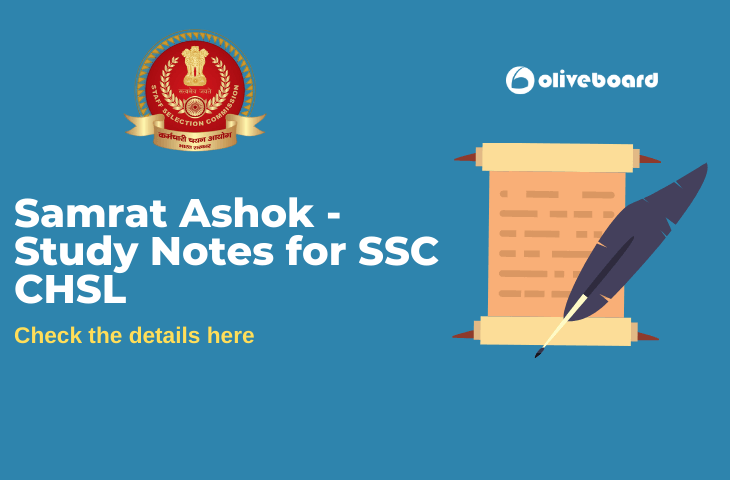Samrat Ashoka: Ashoka or Samrat Ashok or Emperor Ashoka was one of the greatest emperors of India belonging to the Maurya Dynasty. Under his rule, the Mauryan Empire extended from Afghanistan in the west to Bangladesh in the east. It can be said that the whole of the Indian subcontinent was under Ashoka’s rule except present-day Kerala, Tamil Nadu and Sri Lanka.
Ashoka – Family History
Ashoka was the son of Bindusara and Subhadrangi. He was the grandson of the great emperor and founder of the Maurya Dynasty, Chandragupta Maurya. Samrat Ashok was born in 304 B.C in Pataliputra which is present-day Patna. His reign lasted from 268 B.C to 232 B.C till his death.
Mauryan Empire
Pataliputra was the capital of the Mauryan Empire. Mauryan Empire was established by Chandragupta Maurya, the grandfather of Ashoka in the year 321 B.C by defeating Dhana Nanda, who was the last of the Nanda rulers.
Also, read in detail: Mauryan Empire
Samrat Ashoka – Names
Ashoka was known by many names during his lifetime, some of the names Samrat Ashoka, Piyadashi ( Sanskrit. Priyadarshi, He who regards everyone with affection) and Devanampiya (Sanskrit: Devanampriya, “Beloved of the Gods”). Ashoka was also known by the name Chandashoka (before converting to Buddhism) and Dharmashoka ( after converting to Buddhism)
Ashoka – Rise to Power
Ashoka rose to power by defeating his brothers after the death of his father Bindusara in 272 B.C. He extended his empire by conquering nearby areas. The battle of Kalinga ( present-day Odisha) was fought in 265 B.C in which Kalinga was completely destroyed and thousands of people died.
The scenes of war disturbed Ashoka so much that he decided to leave violent ways and adopt a religious way of life.
Ashoka – Converting to Buddhism
Ashoka converted to Buddhism in 263 B.C under the guidance of Moggaliputta Tissa, a Buddhist monk.
Ashoka’s Dhamma
Ashoka’s dhamma or dharma was one of the notable things after his conversion to Buddhism. He asked all his citizens to avoid animal slaughter and practice ahimsa and truthfulness.
To spread his words of Dharma, Ashoka erected edicts and pillars which are inscribed with religious teachings. Most of his edicts are written in Pali and Prakrit in Brahmi Script. He also sent his kids to spread the word of Buddha on foreign lands. His kids Mahinda and Sanghamitra went to Sri Lanka carrying the teachings of Buddha.
Ashoka – Sources of Information
The main sources of information about Ashoka are Buddhist sources and Ashoka edicts. In addition to that Ashokavadana ( in Sanskrit), Dipavamsa and Mahavamsa ( in Pali) from Sri Lanka provide an account of Ashoka.
Conclusion
Ashoka or Samrat Ashoka was one of the greatest emperors in the history of India. He is also regarded as one of the most religious emperors who helped preach the teachings of Buddhism in India and neighbouring countries.
This topic falls under the History of India which is an important section in the General Awareness syllabus of SSC CHSL Tier-1. We hope that candidates will find this article helpful in their SSC CHSL Preparation. Stay connected to Oliveboard for more updates.
Samrat Ashoka – FAQs
Ashoka was born in 304 B.C
Ashoka was born in Pataliputra, the capital of the Mauryan Empire.
Chandragupta Maurya established Mauryan Empire in 321 B.C
Ashoka was known as Devanampiya (Sanskrit: Devanampriya, “Beloved of the Gods”)

Hello there! I’m a dedicated Government Job aspirant turned passionate writer & content marketer. My blogs are a one-stop destination for accurate and comprehensive information on exams like Regulatory Bodies, Banking, SSC, State PSCs, and more. I’m on a mission to provide you with all the details you need, conveniently in one place. When I’m not writing and marketing, you’ll find me happily experimenting in the kitchen, cooking up delightful treats. Join me on this journey of knowledge and flavors!
